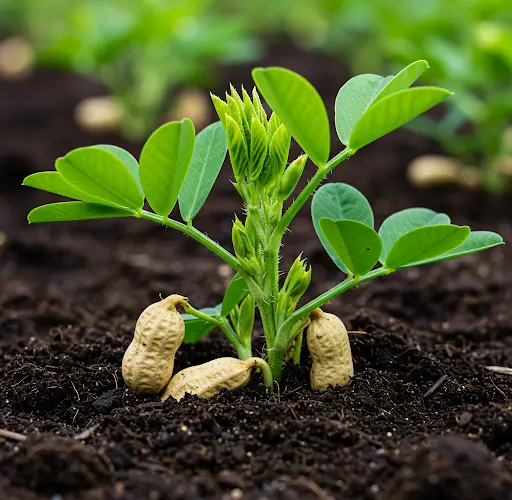Grow a Bountiful Harvest of Peanuts with This Tip: Lots of Tubers and Very Delicious!
Peanuts are a fantastic crop that you can grow at home with ease. Unlike traditional nuts, peanuts grow underground, forming delicious and nutritious tubers. With the right techniques, you can cultivate a bountiful harvest, ensuring you get large, flavorful peanuts that are perfect for snacking, cooking, or making homemade peanut butter. Whether you have a garden, a small backyard, or even containers, this guide will show you how to grow a successful peanut crop with simple and effective methods.
Why Grow Peanuts at Home?
Peanuts are an excellent crop for home gardeners because they:
- Are Nutrient-Rich: High in protein, healthy fats, and essential vitamins.
- Improve Soil Quality: As legumes, they fix nitrogen in the soil, making it more fertile for other plants.
- Require Minimal Care: With proper soil and water management, peanuts grow with little maintenance.
- Are Highly Versatile: You can enjoy them roasted, boiled, ground into peanut butter, or used in various dishes.
Step 1: Choosing the Right Peanut Variety
Different peanut varieties are suited to various climates and growing conditions. The four main types include:
- Runner Peanuts: Used for peanut butter; require a longer growing season.
- Virginia Peanuts: Large and ideal for roasting.
- Spanish Peanuts: Smaller, sweeter, and great for snacking.
- Valencia Peanuts: Popular for boiling and have a rich flavor.
For home gardens, Valencia and Virginia peanuts are excellent choices due to their high yield and adaptability.
Step 2: Preparing the Soil for Peanuts
Peanuts thrive in well-draining, loose, and sandy soil with a slightly acidic to neutral pH (5.8-7.0). Here’s how to prepare the best growing environment:
- Choose a Sunny Location: Peanuts need 6-8 hours of direct sunlight daily.
- Loosen the Soil: Use a garden fork or tiller to loosen the soil up to 12 inches deep.
- Improve Drainage: If your soil is heavy, mix in sand, compost, or well-rotted manure.
- Avoid High-Nitrogen Fertilizers: Peanuts fix their own nitrogen, so using too much nitrogen-rich fertilizer can hinder tuber development.
Pro Tip:
Adding gypsum or wood ash improves calcium levels, which helps develop strong peanut pods.
Step 3: Planting Peanuts the Right Way
Peanuts grow from raw, unroasted peanuts still in their shells. If you buy raw peanuts from a store, ensure they are fresh and untreated.
Planting Process:
- Shell the Peanuts: Carefully remove them from their shells without damaging the seed.
- Soak the Seeds: Soak the peanut seeds in water overnight to speed up germination.
- Plant at the Right Time: Peanuts grow best in warm temperatures (70-80°F). Plant them in early spring after the last frost.
- Space the Seeds Properly: Plant seeds 1-2 inches deep and 6-8 inches apart in rows spaced 24 inches apart.
- Cover with Soil: Lightly cover the seeds with soil and water well.
Pro Tip:
If planting in containers, choose a deep pot (at least 12-16 inches) to allow tuber formation.
Step 4: Providing Proper Care
Watering:
- Keep the soil moist but not soggy. Peanuts need consistent moisture, especially during flowering and pod formation.
- Reduce watering near harvest time to prevent rot and improve flavor.
Sunlight:
- Ensure at least 6-8 hours of direct sunlight daily for maximum yield.
Mulching:
- Apply a layer of straw or dried leaves to retain moisture, suppress weeds, and maintain soil temperature.
Fertilizing:
- Use organic fertilizers like compost, bone meal, or fish emulsion for steady growth.
- Avoid high-nitrogen fertilizers, as they encourage leaf growth instead of tuber development.
Weed Control:
- Keep the peanut bed weed-free, especially during early growth.
- Avoid deep cultivation, as peanut plants form underground tubers.
Step 5: Encouraging Maximum Yield
Hilling the Soil:
- Once the peanut plants start flowering, mound soil around the base of the plant to help pods develop underground.
- Repeat this process 2-3 times during the growing season.
Support Flowering and Pegging:
- Peanuts produce yellow flowers, which send pegs into the soil to form tubers.
- Ensure the soil remains loose and aerated so pegs can penetrate easily.
Pest and Disease Prevention:
- Common Pests: Aphids, leafhoppers, and root-knot nematodes can affect peanut plants.
- Solution: Use neem oil or insecticidal soap to deter pests naturally.
- Disease Prevention: Ensure proper drainage and avoid overwatering to prevent fungal infections like leaf spot and root rot.
Step 6: Harvesting Peanuts
Peanuts take 90-120 days to mature, depending on the variety. Signs that your peanuts are ready to harvest include:
- Leaves turning yellow and drying out.
- Pods developing a rough texture.
- Test a few pods by digging them up; if the inner skin (seed coat) is fully colored, they’re ready.
How to Harvest Peanuts:
- Loosen the soil with a fork before pulling up the plant.
- Shake off excess soil and let the whole plant dry for a few days.
- Cure the Peanuts: Hang the plants in a dry, ventilated area for 2-3 weeks to enhance flavor and longevity.
Pro Tip:
For boiled peanuts, harvest when the shells are still soft and moist.
Step 7: Storing and Enjoying Your Peanuts
After curing, store peanuts in a cool, dry place. You can:
- Roast them for a crispy snack.
- Boil them for a delicious Southern-style treat.
- Grind them into homemade peanut butter.
- Use them in cooking for salads, sauces, and desserts.
Conclusion
Growing peanuts at home is an enjoyable and rewarding experience. With proper soil preparation, planting techniques, and care, you can harvest large, flavorful peanuts right from your garden or containers. Whether you roast them, boil them, or make peanut butter, homegrown peanuts taste far better than store-bought ones. Start your peanut-growing journey today and enjoy a bountiful harvest of delicious tubers!



